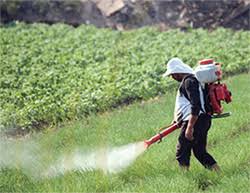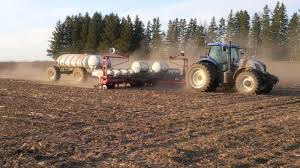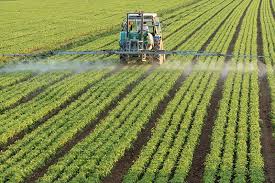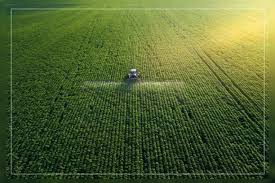Large-scale commercial agriculture refers to the production of crops and livestock at a significant scale, primarily focused on generating profit.
This method of farming is characterized by its reliance on advanced technology, mechanization, and the use of chemical inputs such as fertilizers and pesticides.
It plays a crucial role in feeding the growing global population and has dramatically increased food production over the past few decades.
However, despite its contributions to food security and economic growth, large-scale commercial agriculture poses significant environmental challenges that require careful management and innovative solutions.
Soil Degradation and Erosion
Soil degradation is one of the most pressing environmental issues associated with large-scale commercial agriculture. This term refers to the decline in soil quality caused by various factors, including continuous cultivation, the overuse of chemical fertilizers, and heavy machinery.
In many commercial farming operations, the soil is subjected to intensive farming practices that strip it of its natural nutrients.
When crops are grown repeatedly in the same area without proper soil management practices, it leads to nutrient depletion, making the soil less fertile over time.
Erosion is another critical concern related to soil degradation. This occurs when wind or water washes away the top layer of soil, which is rich in nutrients and essential for plant growth. Factors contributing to soil erosion include deforestation, overgrazing, and poor land management practices.
For instance, when vegetation is removed to make way for large fields, the soil becomes more susceptible to erosion. As a result, the productive capacity of the land is diminished, leading to lower crop yields and the need for more fertilizers to compensate for lost nutrients.
The economic implications of soil degradation and erosion are significant. Farmers may face decreased yields, leading to reduced profits. In extreme cases, entire farming operations can become unviable, resulting in abandoned farmland.
This not only affects farmers and their families but also impacts local economies reliant on agriculture.
To mitigate soil degradation and erosion, farmers can implement several sustainable practices. These include crop rotation, which helps maintain soil fertility by alternating different types of crops in a specific area.
Additionally, cover cropping involves planting cover crops during off-seasons to protect the soil from erosion and add organic matter. Conservation tillage is another technique that minimizes soil disturbance, preserving soil structure and preventing erosion.
Water Usage and Pollution

Water is a vital resource for agriculture, and large-scale commercial farming often requires significant amounts of water, particularly for irrigation. In regions where rainfall is insufficient, farmers rely on irrigation systems to ensure their crops receive adequate moisture.
However, the extensive water use associated with large-scale agriculture can lead to the depletion of local water resources.
In some areas, over-extraction of groundwater for irrigation has resulted in lowered water tables, making it increasingly difficult for communities to access clean water for drinking and domestic use.
Moreover, agricultural runoff is a major source of water pollution. When it rains, excess fertilizers, pesticides, and herbicides can wash off the fields and into nearby rivers, lakes, and streams.
This runoff can lead to several environmental issues, including the contamination of drinking water sources, the degradation of aquatic ecosystems, and the proliferation of harmful algal blooms.
Algal blooms can deplete oxygen levels in the water, harming fish and other aquatic life, and can also produce toxins harmful to humans and animals.
To address the challenges of water usage and pollution, large-scale commercial farmers can adopt more efficient irrigation practices, such as drip irrigation, which delivers water directly to the plant roots, minimizing waste.
Implementing buffer zones with vegetation around water bodies can also help filter out pollutants before they enter the water supply.
Additionally, farmers can engage in integrated pest management (IPM) practices, which reduce the need for chemical pesticides by using biological controls and other methods to manage pest populations sustainably.
Deforestation and Habitat Destruction
The expansion of large-scale agriculture often involves clearing vast areas of forests, leading to deforestation and habitat destruction.
This process not only eliminates trees but also disrupts entire ecosystems, threatening the survival of countless plant and animal species. Forests play a vital role in maintaining biodiversity, providing habitats for wildlife, and regulating local climates.
The loss of forests due to agricultural expansion contributes to the decline of species that rely on these habitats, leading to reduced biodiversity and altering ecosystem functions.
In many regions, deforestation is driven by the demand for agricultural land to grow cash crops like soy, palm oil, and sugarcane.
For instance, in the Amazon rainforest, vast areas have been cleared for soy production and cattle ranching, significantly impacting the local and global environment.
This loss of forested areas not only affects wildlife but also contributes to climate change, as trees are critical for absorbing carbon dioxide from the atmosphere.
The social implications of deforestation are also significant. Indigenous communities that rely on forests for their livelihoods are often displaced, losing their homes and cultural heritage. The destruction of forests can also lead to social conflicts over land use and resource rights.
To mitigate the impact of deforestation and habitat destruction, sustainable agricultural practices can be implemented.
Agroforestry, which integrates trees and shrubs into agricultural landscapes, can enhance biodiversity while still allowing for productive farming.
Additionally, supporting policies that promote sustainable land-use practices can help balance agricultural expansion with the need to protect forests and ecosystems.
Read Also: How often you need to Change Water in your Fish Farm
Greenhouse Gas Emissions and Climate Change

Large-scale commercial agriculture contributes to greenhouse gas emissions in several ways. The use of synthetic fertilizers, for example, releases nitrous oxide, a potent greenhouse gas that contributes to global warming.
Furthermore, livestock farming generates methane, particularly from cattle, as they produce methane during digestion and through manure management. Deforestation for agricultural expansion reduces the planet’s capacity to absorb carbon dioxide, further exacerbating climate change.
The agricultural sector is a significant source of greenhouse gas emissions, accounting for about 10-12% of total emissions globally.
The impacts of climate change, in turn, can affect agricultural productivity, leading to a cycle of challenges.
Rising temperatures, changing precipitation patterns, and extreme weather events can all disrupt crop yields and livestock health.
To address these challenges, farmers can adopt practices that reduce emissions, such as improved manure management and the use of cover crops to enhance soil health.
Additionally, implementing sustainable livestock management practices can help minimize methane emissions.
Transitioning to agroecological approaches, which focus on biodiversity and sustainable practices, can further contribute to mitigating climate change while maintaining agricultural productivity.
Loss of Biodiversity in Large-Scale Commercial Agriculture
Biodiversity refers to the variety of life forms on Earth, including the diversity of species, ecosystems, and genetic resources.
Large-scale commercial agriculture has significantly contributed to the loss of biodiversity through practices that prioritize monoculture growing a single crop over a large area. While monoculture can increase short-term yields and simplify farming operations, it comes at the cost of ecosystem health and resilience.
Impact of Monoculture on Ecosystems
Monoculture farming reduces the diversity of plants, which can lead to the decline of various species that depend on a diverse ecosystem for survival.
When a single crop species dominates the landscape, it can result in habitat loss for wildlife, diminishing the variety of insects, birds, and other organisms that thrive in more diverse environments.
This simplification of ecosystems can disrupt natural processes, such as pollination and pest control, which are vital for agricultural productivity.
Consequences for Agriculture and Food Security
The decline in biodiversity also has significant implications for agricultural resilience.
A diverse ecosystem is more resilient to pests, diseases, and environmental changes, while monocultures can be more vulnerable to these threats.
If a disease or pest targets a specific crop variety, entire fields can be devastated, leading to food shortages and economic losses for farmers.
Moreover, loss of genetic diversity in crop species can reduce their adaptability to changing climatic conditions, threatening food security in the long run.
Strategies for Biodiversity Conservation
To mitigate the loss of biodiversity, farmers can adopt several strategies:
1. Crop Rotation: Alternating different crops in the same area can help restore soil health and reduce pest populations.
2. Intercropping: Growing two or more crops together can increase plant diversity, improve soil fertility, and enhance pest control.
3. Buffer Zones: Maintaining natural vegetation around fields can provide habitats for beneficial organisms and improve ecosystem services.
4. Agroforestry: Integrating trees and shrubs into agricultural systems can enhance biodiversity and improve productivity.
Read Also: 14 Medicinal Health Benefits of Ghost Pepper (Capsicum Chinese)
Impact of Pesticides and Fertilizers in Large-Scale Commercial Agriculture

Pesticides and fertilizers are essential inputs in large-scale commercial agriculture that aim to enhance crop yields and control pests.
However, their use has raised significant environmental and health concerns due to their impact on ecosystems, human health, and soil health.
Environmental Effects of Pesticides
Pesticides can have detrimental effects on non-target species, including beneficial insects, birds, and aquatic life. When pesticides are applied, they can drift from the intended application area and contaminate nearby ecosystems.
This contamination can lead to the decline of pollinator populations, such as bees, which are crucial for crop pollination. Additionally, runoff from fields treated with pesticides can enter water bodies, harming aquatic ecosystems and posing risks to human health through contaminated drinking water.
Impact of Fertilizers on Soil Health
The excessive use of synthetic fertilizers can lead to soil degradation over time. While fertilizers can temporarily boost crop yields, they do not improve soil structure or fertility in the long term.
Continuous reliance on chemical fertilizers can lead to nutrient imbalances, harming soil microorganisms essential for nutrient cycling.
Furthermore, nutrient runoff from fertilized fields contributes to water pollution and eutrophication, causing harmful algal blooms that deplete oxygen levels in water bodies.
Integrated Pest Management (IPM)
To address the negative impacts of pesticides and fertilizers, farmers can implement Integrated Pest Management (IPM) practices. IPM emphasizes the use of natural predators, crop rotation, and other sustainable practices to manage pests while minimizing reliance on chemical inputs.
Additionally, organic fertilizers and practices that enhance soil health can help reduce the need for synthetic fertilizers.
Energy Consumption in Commercial Agriculture
Large-scale commercial agriculture is energy-intensive, relying on fossil fuels for machinery, transportation, and the production of synthetic fertilizers and pesticides. The energy consumption associated with agriculture has several environmental implications.
Greenhouse Gas Emissions from Energy Use
The reliance on fossil fuels in commercial agriculture contributes significantly to greenhouse gas emissions.
Fuel use for tractors, harvesters, and transport vehicles releases carbon dioxide and other greenhouse gases into the atmosphere.
Furthermore, the production of synthetic fertilizers and pesticides is energy-intensive, adding to the carbon footprint of agricultural practices.
Sustainable Energy Practices
To mitigate the energy consumption of commercial agriculture, farmers can adopt more sustainable energy practices:
1. Renewable Energy Sources: Utilizing solar, wind, or bioenergy can help reduce dependence on fossil fuels.
2. Energy-Efficient Equipment: Investing in energy-efficient machinery can lower fuel consumption and emissions.
3. Precision Agriculture: Implementing technology that optimizes inputs and reduces waste can decrease energy use and improve overall efficiency.
Mitigating Environmental Impact in Large-Scale Agriculture
The environmental impacts of large-scale commercial agriculture, including biodiversity loss, pesticide and fertilizer use, and energy consumption, necessitate urgent action to promote sustainability. Here are several approaches to mitigate these impacts:
Sustainable Practices Implementation
1. Agroecology: Adopting agroecological principles can promote biodiversity and resilience while enhancing food security.
2. Conservation Agriculture: Techniques such as no-till farming can help maintain soil structure and prevent erosion.
3. Water Management: Efficient irrigation systems and rainwater harvesting can reduce water use and improve sustainability.
Policy and Education
1. Government Incentives: Providing incentives for farmers to adopt sustainable practices can encourage a shift towards environmentally friendly agriculture.
2. Farmer Education: Training programs focused on sustainable practices can empower farmers to implement solutions that benefit both their operations and the environment.
Sustainable Agricultural Practices for the Future
To ensure a sustainable future for agriculture, it is essential to adopt practices that balance productivity with environmental health. Here are key sustainable agricultural practices to consider:
1. Organic Farming: Organic farming avoids synthetic chemicals, relying on natural inputs and sustainable practices. This approach can enhance soil health, promote biodiversity, and reduce environmental pollution.
2. Permaculture: Permaculture designs agricultural systems that mimic natural ecosystems, integrating plants, animals, and natural resources in a sustainable manner. This holistic approach promotes biodiversity and resource efficiency.
3. Regenerative Agriculture: Regenerative agriculture focuses on restoring soil health and biodiversity while increasing agricultural productivity. Techniques include cover cropping, crop rotation, and holistic grazing management.
4. Integrated Crop-Livestock Systems: Combining crop and livestock production can enhance nutrient cycling, improve soil health, and diversify farm income. This integrated approach can help reduce reliance on external inputs.
5. Vertical and Urban Farming: Utilizing vertical and urban farming techniques can maximize space, reduce transportation emissions, and provide fresh produce in urban areas, promoting local food systems.
6. Technology Adoption: Leveraging technology such as precision agriculture, data analytics, and automation can enhance efficiency, reduce waste, and minimize environmental impact.
Large-scale commercial agriculture has significantly increased food production but poses several environmental challenges, including soil degradation, water usage, deforestation, and greenhouse gas emissions.
To ensure a sustainable future for agriculture, it is crucial to adopt practices that minimize these impacts while continuing to feed a growing global population.
Do you have any questions, suggestions, or contributions? If so, please feel free to use the comment box below to share your thoughts. We also encourage you to kindly share this information with others who might benefit from it. Since we can’t reach everyone at once, we truly appreciate your help in spreading the word. Thank you so much for your support and for sharing!
Read Also: The Effect of Heat Stress on Animal Productivity
Frequently Asked Questions
We will update this section soon.

